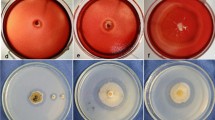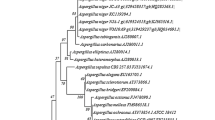Abstract
Although a number of filamentous fungi, such as Trichoderma and Aspergillus, are well known as producers of cellulases, xylanases, and accessory cellulolytic enzymes, the search for new strains and new enzymes has become a priority with the increase in diversity of biomass sources. Moreover, according to the type of pretreatment applied, biomass of the same type may require different enzyme blends to be efficiently hydrolyzed. This study evaluated cellulases, xylanases, and β-glucosidases produced by two fungi, the thermotolerant Acrophialophora nainiana and Ceratocystis paradoxa. Cells were grown in submerged culture on three carbon sources: lactose, wheat bran, or steam-pretreated sugarcane bagasse, a commonly used cattle feed in Brazil. Xylanase and endo-1-4-β-glucanase (CMCase) highest production were found in A. nainiana growing on lactose and reached levels of 2,200 and 2,016 IU/L, respectively. C. paradoxa showed highest activity for xylanase when grown on wheat bran and for β-glucosidase when grown on steam-treated bagasse, at levels of 12,728 and 1,068 IU/mL, respectively.


Similar content being viewed by others
References
Azzam, A. M. (1989). Journal of Environmental Science and Health. Part B, 24(4), 421–433.
Bjerre, A. B., Olesen, A. B., & Fernqvist, T. (1996). Biotechnology and Bioengineering, 49, 568–577.
Cadoche, L., & López, G. D. (1989). Biological Wastes, 30, 153–157.
Dale, B. E., Henk, L. L., & Shiang, M. (1984). Developments in Industrial Microbiology, 26, 223–233.
Duff, S. J. B., & Murray, W. D. (1996). Bioresource Technology, 55, 1–33.
Reshamwala, S., Shawky, B. T., & Dale, B. E. (1995). Appl Biochem Biotechnol, 51/52, 43–55.
Wright, J. D. (1998). Chemical Engineering Progress, 84(8), 62–74.
Medeiros, R. G., Soffner, M. L. A., Thomé, J. A., Cacais, A. O. G., Estelles, R. S., Salles, B. C., et al. (2000). Biotechnology Progress, 16, 522–524.
Moutia, Y., & Saumtally, S. (1999). Technical report: Mauritius Sugar Industry Research Institute AMAS. Réduit: Food and Agricultural Research Council.
Ghose, T. K. (1987). Pure and Applied Chemistry, 59(2), 257–268.
Miller, L. (1959). Analytical Chemistry, 31, 426–428.
Filho, E. X. F., Puls, J., & Coughlan, M. P. (1993). Journal of Industrial Microbiology, 11, 171–180.
Cardoso, O. A. V., & Filho, E. X. F. (2003). FEMS Microbiology Letters, 223(2), 309–314.
Author information
Authors and Affiliations
Corresponding author
Rights and permissions
About this article
Cite this article
Barros, R.R.O., Oliveira, R.A., Gottschalk, L.M.F. et al. Production of Cellulolytic Enzymes by Fungi Acrophialophora nainiana and Ceratocystis paradoxa Using Different Carbon Sources. Appl Biochem Biotechnol 161, 448–454 (2010). https://doi.org/10.1007/s12010-009-8894-3
Received:
Accepted:
Published:
Issue Date:
DOI: https://doi.org/10.1007/s12010-009-8894-3




